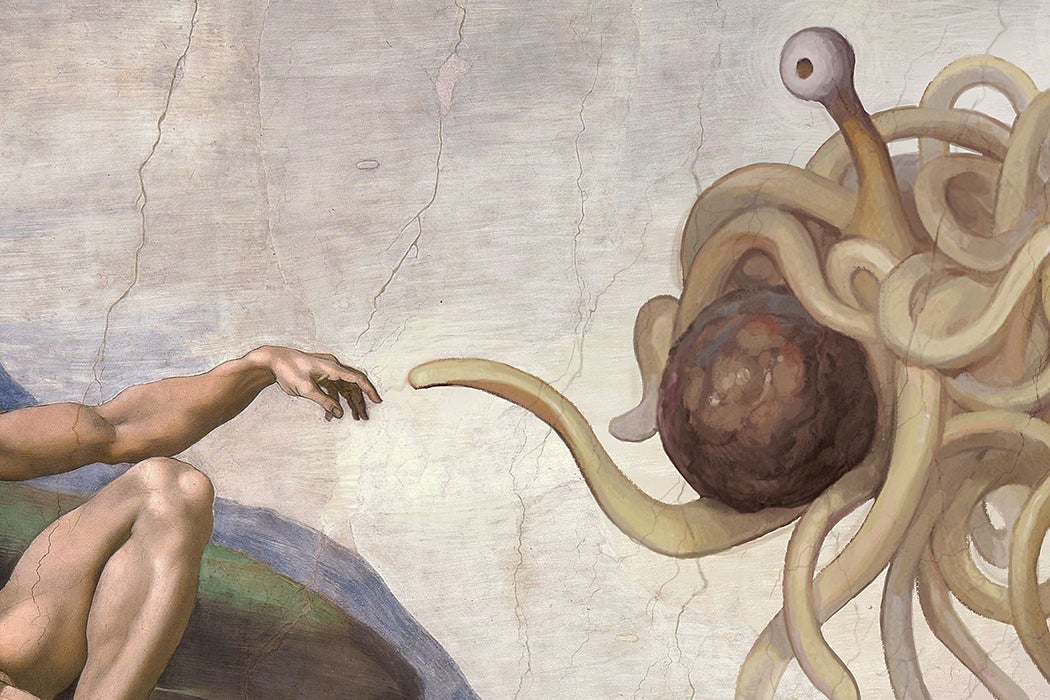If you were planning on attending noodle mass (nuddelmasse) in Templin, Germany this year, you might have to ask a local for directions. A Brandenburg court has ruled that the Church of the Flying Spaghetti Monster (FSM) is no longer permitted to display placards advertising its nuddelmasse services at any of the town’s four entrances, where they once hung alongside similar signs for the local Lutheran, Catholic, and Evangelical churches. This is a major setback for the young church’s ongoing fight—in the birthplace of Protestant Reformation, no less—for public legitimacy.
The Church of the Flying Spaghetti Monster began in 2005 with a satiric open letter written by then-25-year-old Bobby Henderson in response to the Kansas Board of Education’s decision to teach the theory of intelligent design alongside evolution in public schools. Henderson argued that schools ought also to devote class time to teaching the theory that a flying spaghetti monster had created the universe. This, he reasoned, was as probable a version of intelligent design as any other. The letter inspired a biblical flood’s worth of memes and launched a religious group that now claims a global membership. As this so-called Pastafarianism has grown, some branches of the FSM church have started demanding the rights and privileges enjoyed by more established religious organizations. What started as a fake religion is now angling to be an authentic one.
In his article “Fake Religion: Ordeals of Authenticity in the Study of Religion,” David Chidester argues that the concept of religion has always been leveraged as the authentic alternative to chicanery and superstition, and accusations of fake religion have long been a strategy to undercut the claims of religious upstarts. Mohammed, for instance, was labeled a fraudster, and more recently Joseph Smith, a charlatan. Since the 1960s, however, avowedly fake religions designed to repudiate conventional notions of religious authenticity have thrived.
Invented religions tend to embrace irony over piety and satire over sincerity, preferring to critique existing institutions than to displace—or, worse—to join them. In the 1990s and 2000s, such groups exploded across the internet. Virtual religions like Discordianism and the First Church of the Last Laugh challenged “any preconceptions we might have about religious authenticity.” But when an invented religion exits the virtual space of play and enters the public sphere, its own conceptions of religious authenticity inevitably clash with those of the state.
When the Brandenburg court decided on August 2nd, 2017 to deny the FSM church recognition as a religious group, it did so because “the critique of beliefs expressed in it is not a comprehensive system of thought.” For the court, Pastafarianism’s satiric origins, along with the fact that its iconography and rituals are so clearly intended to hold an absurdist mirror to Christianity, render it inauthentic. This is a hard charge to deny. At the same time, the court implicitly devalued the humor and play at the heart of Pastafarianism as valid elements of authentic religion, privileging instead history, solemnity, and intellectual coherence.
Spearheading the church’s quixotic fight with the German judiciary has been Rüdiger Weida (aka Brother Spaghettus) who upon hearing the ruling accused the court of judging the FSM church not by its German branch (or is it tentacle?) alone, which Weida insists is a secular humanist organization merely adorned in cookware and eye patches, but by its American counterpart, which he has described as “relatively ridiculous. It is only about partying and pasta recipes. There is only a marginal social concern there.” Perhaps Brother Spaghettus’s frustration with his colander-clad brethren on the other side of the Atlantic will soon propel him into the role of a Pastafarian Luther. This might even help him when he takes his case next to the European Court of Justice, since nothing is more authentically religious than a good old fashioned schism.







